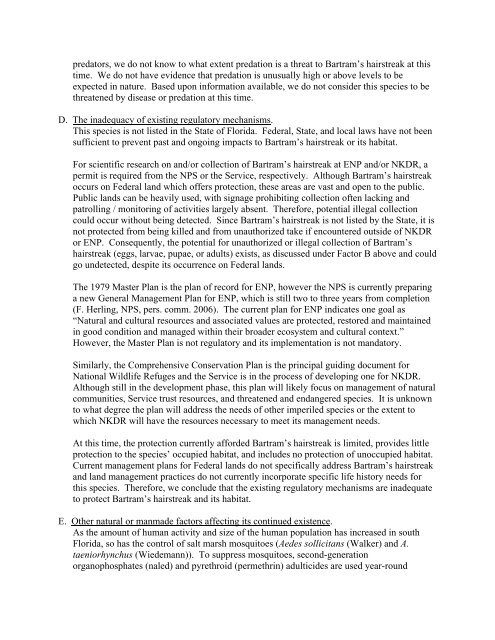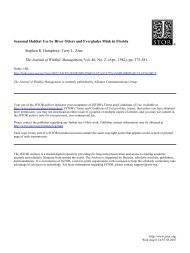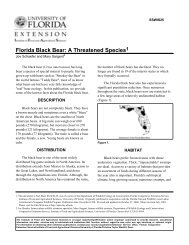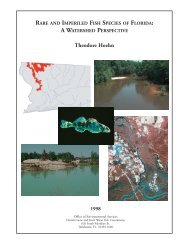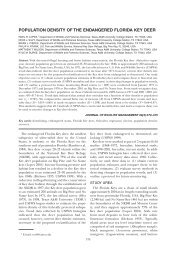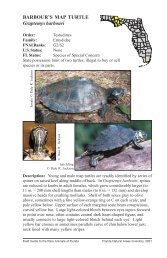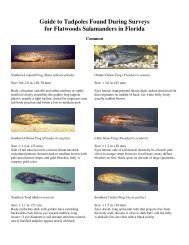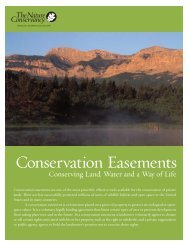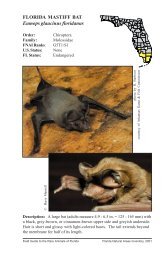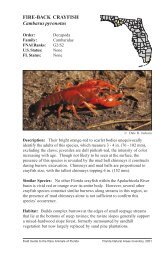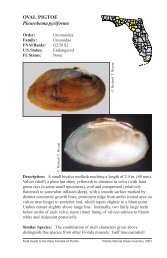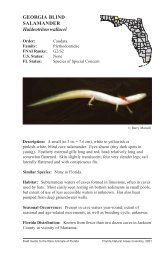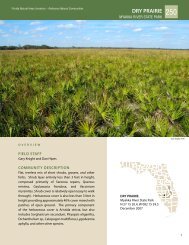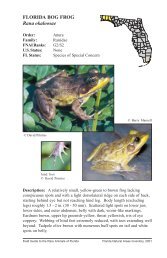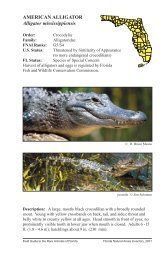Bartram's hairstreak butterfly - Florida Wildlife Conservation Guide
Bartram's hairstreak butterfly - Florida Wildlife Conservation Guide
Bartram's hairstreak butterfly - Florida Wildlife Conservation Guide
Create successful ePaper yourself
Turn your PDF publications into a flip-book with our unique Google optimized e-Paper software.
predators, we do not know to what extent predation is a threat to Bartram’s <strong>hairstreak</strong> at this<br />
time. We do not have evidence that predation is unusually high or above levels to be<br />
expected in nature. Based upon information available, we do not consider this species to be<br />
threatened by disease or predation at this time.<br />
D. The inadequacy of existing regulatory mechanisms.<br />
This species is not listed in the State of <strong>Florida</strong>. Federal, State, and local laws have not been<br />
sufficient to prevent past and ongoing impacts to Bartram’s <strong>hairstreak</strong> or its habitat.<br />
For scientific research on and/or collection of Bartram’s <strong>hairstreak</strong> at ENP and/or NKDR, a<br />
permit is required from the NPS or the Service, respectively. Although Bartram’s <strong>hairstreak</strong><br />
occurs on Federal land which offers protection, these areas are vast and open to the public.<br />
Public lands can be heavily used, with signage prohibiting collection often lacking and<br />
patrolling / monitoring of activities largely absent. Therefore, potential illegal collection<br />
could occur without being detected. Since Bartram’s <strong>hairstreak</strong> is not listed by the State, it is<br />
not protected from being killed and from unauthorized take if encountered outside of NKDR<br />
or ENP. Consequently, the potential for unauthorized or illegal collection of Bartram’s<br />
<strong>hairstreak</strong> (eggs, larvae, pupae, or adults) exists, as discussed under Factor B above and could<br />
go undetected, despite its occurrence on Federal lands.<br />
The 1979 Master Plan is the plan of record for ENP, however the NPS is currently preparing<br />
a new General Management Plan for ENP, which is still two to three years from completion<br />
(F. Herling, NPS, pers. comm. 2006). The current plan for ENP indicates one goal as<br />
“Natural and cultural resources and associated values are protected, restored and maintained<br />
in good condition and managed within their broader ecosystem and cultural context.”<br />
However, the Master Plan is not regulatory and its implementation is not mandatory.<br />
Similarly, the Comprehensive <strong>Conservation</strong> Plan is the principal guiding document for<br />
National <strong>Wildlife</strong> Refuges and the Service is in the process of developing one for NKDR.<br />
Although still in the development phase, this plan will likely focus on management of natural<br />
communities, Service trust resources, and threatened and endangered species. It is unknown<br />
to what degree the plan will address the needs of other imperiled species or the extent to<br />
which NKDR will have the resources necessary to meet its management needs.<br />
At this time, the protection currently afforded Bartram’s <strong>hairstreak</strong> is limited, provides little<br />
protection to the species’ occupied habitat, and includes no protection of unoccupied habitat.<br />
Current management plans for Federal lands do not specifically address Bartram’s <strong>hairstreak</strong><br />
and land management practices do not currently incorporate specific life history needs for<br />
this species. Therefore, we conclude that the existing regulatory mechanisms are inadequate<br />
to protect Bartram’s <strong>hairstreak</strong> and its habitat.<br />
E. Other natural or manmade factors affecting its continued existence.<br />
As the amount of human activity and size of the human population has increased in south<br />
<strong>Florida</strong>, so has the control of salt marsh mosquitoes (Aedes sollicitans (Walker) and A.<br />
taeniorhynchus (Wiedemann)). To suppress mosquitoes, second-generation<br />
organophosphates (naled) and pyrethroid (permethrin) adulticides are used year-round


